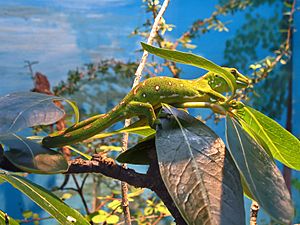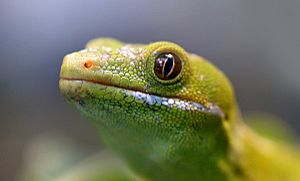Northland green gecko facts for kids
Quick facts for kids Northland green gecko |
|
|---|---|
 |
|
| at Orana Wildlife Park, Christchurch | |
| Conservation status | |
 Sparse (NZ TCS) |
|
| Scientific classification | |
| Genus: |
Naultinus
|
| Species: |
grayii
|
| Synonyms | |
The Northland green gecko or Gray's tree gecko (Naultinus grayii) is a special type of gecko. Geckos are lizards that belong to the Gekkonidae family. This gecko lives only in the Northland area of New Zealand, north of Whangaroa. It is one of the rarest and most wanted lizards in the world.
Contents
What's in a Name?
The Northland green gecko was first described by a scientist named Thomas Bell in 1843. Its scientific name, grayii, was chosen to honor a British scientist named John Edward Gray. He was a herpetologist, which means he studied reptiles and amphibians.
Meet the Northland Green Gecko
The Northland green gecko is a bright, vivid green color. It has grey or gold markings on its back. Male geckos have a blue stripe along their sides, just below their legs. The underside of both male and female geckos is a pale green, sometimes with a yellow tint. Inside its mouth, this gecko has a deep blue color and a bright red tongue!
These geckos can grow up to 200 mm (7.9 in) long, including their tail. Their body length, from snout to vent (the opening at the base of the tail), can be up to 95 mm (3.7 in).
How Northland Green Geckos Live
The Northland green gecko is a diurnal animal. This means it is active during the day, unlike many other geckos that are active at night. You can often find them sun-basking, which means they lie in the sun to warm up.
These geckos live an arboreal lifestyle. This means they spend most of their time in trees. They especially like to live in manuka, kanuka, and mingimingi trees.
Protecting the Northland Green Gecko
The Northland green gecko is considered an "At Risk" species. In 2012, the Department of Conservation in New Zealand gave it this status. This means its numbers are going down, or are expected to go down.
It is very important to protect these geckos. They are also listed as "Data Poor." This means scientists need more information about them to help protect them even better.
Northland Green Geckos in Captivity
Many gecko keepers around the world consider the Naultinus species, including the Northland green gecko, to be very special. They are sometimes called the "Holy Grail" of geckos. Because they are so rare, a pair of these lizards can be very expensive.
Outside of New Zealand, these geckos are most often kept in Europe. Some keepers there have successfully bred them, but it is still very rare to see them.
Why We Must Protect Wild Animals
It is against the law to take animals from their natural homes without permission. In 2001, a tourist was caught trying to take Northland green geckos out of New Zealand. This shows how important it is to keep these rare animals safe in their natural environment. Taking animals from the wild can harm their populations and is illegal.
See also
 In Spanish: Naultinus grayii para niños
In Spanish: Naultinus grayii para niños


